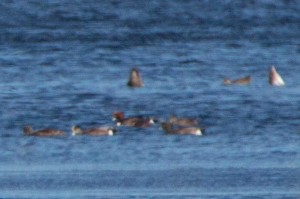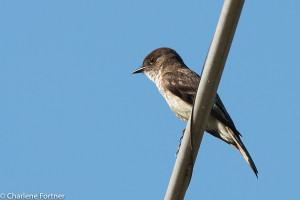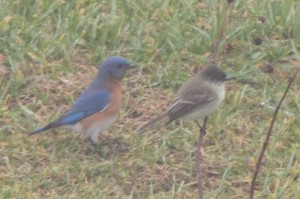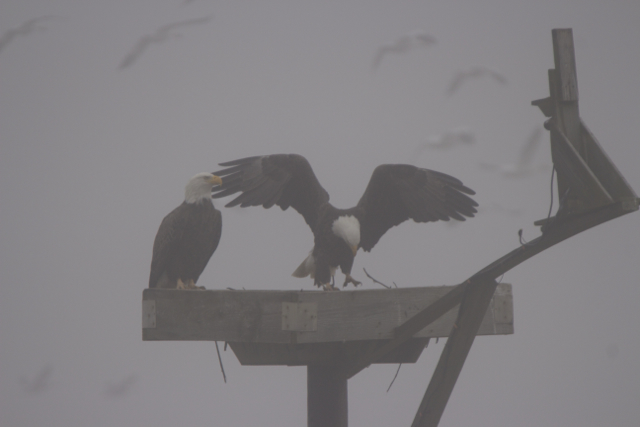December 25, 2014

Common Loon
Indian River Inlet
Dec. 2014
Click for more photos.
Before I came up to Delaware, I made a short list of species I would like to find based on previous reports or likely residents. Top of the list was, of course, the Snowy Owl that we did not find, but also several other species that we did (below in bold). Christmas Day was a great day for birding!
After a rainy Christmas Eve, we started out on Christmas day early at Cape Henlopen. Hoping to get a closer look at the Snow Buntings from a few days ago, our efforts did not pay off. No Snow Buntings. 🙁
On our way to Indian River Inlet we stopped at Silver Lake in Rehoboth to find Canvasback, Mallards, Ruddy Ducks and a lone Great Blue Heron.
Indian River Inlet (north jetty) was cold and windy. Cloud cover was receding and eventually cleared around 11am. We first spotted a Common Loon and later many more. On my to-see list we quickly spotted Long-tailed Ducks. These beautiful ducks are sea-faring and we saw two large groupings. Surf and a lone female Black Scoter were visible. While observing the Long-tailed Ducks we were also treated to a pair of Northern Gannets who came close to the shore, Sanderlings and a Ruddy Turnstone. Upon closer inspection of my photos later, I found we did indeed see the Harlequin Duck that has been hanging out there.

Harlequin Duck
Indian River Inlet, DE
Dec. 2014
Click for more photos.

Long-tailed Duck
Indian River Inlet, DE
Dec. 2014
Click for more photos
As the clouds cleared we drove towards the marina to Burton’s Island. This is my second time birding at this location and I would recommend it. I previously visited this site in April of this year and found it to be a great site for viewing Osprey. The parking lot was muddy, so we parked up on the hill a bit to avoid the possibility of getting stuck. The circular trail crosses a boardwalk to the island. From the boardwalk we viewed some Buffleheads, Double-crested Cormorants, Ruddy Turnstones at the end of a pier and two Belted Kingfishers (both males).

Belted Kingfisher
Burton’s Island, DE
Dec. 2014
Click to enlarge.
On the island, most activity was from small birds: White-throated Sparrows, Yellow-rumpled Warblers, Chickadees, Brown-headed Nuthatches, Northern Cardinals and a single Northern Mockingbird. Leaving the island we spooked a Double-crested Cormorant near the boardwalk.

Yellow-rumped Warbler
Burton’s Island, DE
Dec. 2014
Click for more Warblers.
From Burton’s Island we headed south to Assawoman Wildlife Area. Upon arrival we picked up a map of their auto tour route. Unfortunately, the map was not of great quality, but the road names and turns were well-marked with signs.
From the observation tower we observed the 65 acre pond to the north best during the afternoon light. Canada Geese and several hundred American Wigeon were the majority of the birds in the pond. Two mute swans, both with green neck bands were amidst the flock. The bands were unreadable with my camera and I did not attempt when we used to scope. The unusual find for the day was an Eurasian Wigeon mixed in the flock of American Wigeon. Previously reported in eBird. (A very grainy photo due to the distance.) To the east there was a smaller flock of birds made up of American Black Ducks and American Coots.

Eurasian Wigeon
Assawoman Wildlife Area
Dec. 2014
Click to view a second photo.
At Mulberry Landing we visited the photo blind. There we saw another large flock of American Wigeon close to the blind. Further out we spotted Buffleheads, a Ruddy Duck, and 4 Ring-necked Ducks. The road to Strawberry Landing was closed to vehicles and due to our concern of losing light if we did the hike, we decided to call it a day and bird from the road on the way back home. We saw some small songbirds along the pine area back towards the entrance. To top off the site we had the pleasure of observing an immature Red-shouldered Hawk (thank you to the birders on the Facebook group Delaware Birding for helping me identify it), a Red-tailed Hawk and an American Kestrel (#3).

American Kestrel
Assawoman Wildlife Area, Camp Barnes Rd.
Click for larger photo.
Dec. 2014
We stopped at Indian River Inlet (South jetty) on the way back north to try and find the Harlequin Duck again (remember we didn’t “see” it earlier). We did not see any new species or need to alter our counts from earlier in the day. We got more great views of the Long-tailed ducks.
Swinging back by Cape Henlopen, the point, at the end of the day for just one more quick look for the buntings proved fruitless again. Instead we saw a Northern Gannet to the west of the lighthouse and seven Red-breasted Mergansers to end the day.



























